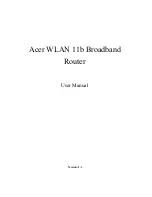
10
•
AP Client.
This mode is for
Dynamic
LAN-to-LAN Bridging. The AP Client auto-
matically establishes bridge links with APs from any vendors.
In either mode, the AP forwards packets between its Ethernet interface and wireless in-
terface for wired hosts on the Ethernet side and wireless host(s) on the wireless side.
There are 2 types of wireless links as specified by the IEEE 802.11 standard.
•
STA-AP.
This type of wireless link is established between an IEEE 802.11 Station
(STA) and an IEEE 802.11 Access Point (AP). A STA is usually a client computer
(PC or PDA) with a WLAN network interface card (NIC). The AP Client mode is ac-
tually an STA.
•
WDS.
This type of wireless link is established between two IEEE 802.11 APs. Wire-
less packets transmitted along the WDS link comply with the IEEE 802.11 WDS
(Wireless Distribution System) format at the link layer.
The relationships among the operational modes and the wireless link types are shown
in the following table:
Table 1. Operational modes vs. wireless link types.
AP/Bridge
AP Client
AP/Bridge
WDS STA-AP
AP Client
STA-AP
To establish a
static
bridge link based on WDS, the AP/bridges at both end of the WDS
link must be
manually
configured with each other’s MAC addresses (see Section 0 for
more information). To establish a
dynamic
bridge link between an AP and an AP Client,
both devices have to be configured with the same SSID and WEP settings. The AP Cli-
ent automatically scans for any AP that is using the matched SSID and establishes a
bridge link with the scanned AP.
NOTE:
Although it’s more convenient to use dynamic bridging, it has a limitation—the
AP Client only can forward TCP/IP packets between its wireless interface and Ethernet
interface; other type of traffic (such as IPX and AppleTalk) is not forwarded.
TIP:
When the AP is configured to be in AP Client, it can be used as an
Ethernet-to-wireless network adapter. For example, a notebook computer equipped with
an Ethernet adapter can be connected to this device with a crossover Ethernet cable for
wireless connectivity to another access point.
















































